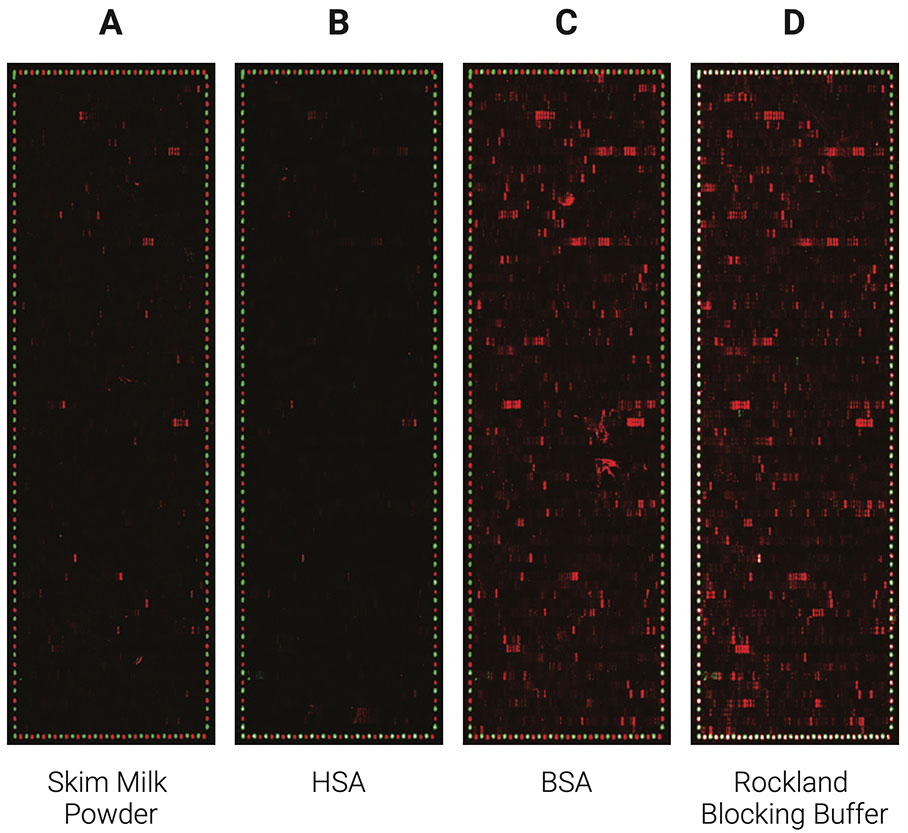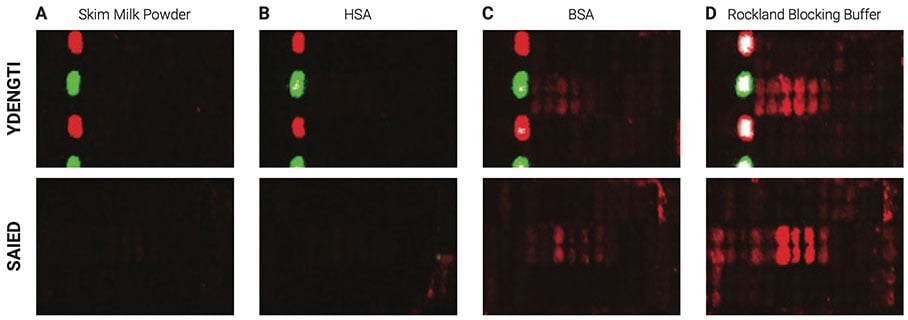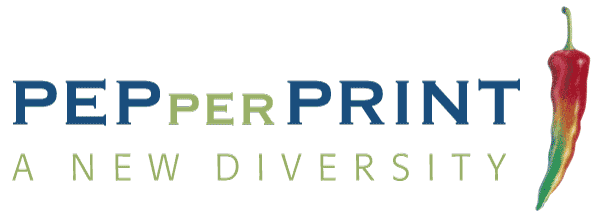Comparison of Different Reagents for Blocking of PEPperCHIP® Peptide Microarrays
Introduction
An essential prerequisite of each immunoassay is the prevention of undesirable background interactions of samples and secondary antibodies with the binding surface, e.g. the microplate for ELISAs, the membrane for Western blots, or the glass slide for protein and peptide microarrays. In principle, any protein that does not specifically bind to the target, the sample, or the secondary antibody can be used for blocking. Commonly used reagents are single proteins or protein mixtures such as casein, bovine serum albumin (BSA), human serum albumin (HSA), or skim milk powder. In addition, some ready-to-use blocking buffers are commercially available. However, there is no “one-size-fits-all” blocking reagent for each application. An efficient blocking buffer should primarily ensure a good signal-to-noise ratio, i.e. block non-specific binding and avoid interfering with the specific binding of the protein or antibody sample to the target. Therefore, it is crucial to identify a well-suited blocking buffer for each type of application individually. This application note compares some of the blocking reagents mentioned above with regard to their blocking performance on PEPperMAP® Peptide Microarrays .
Materials and Methods
After 15 minutes of pre-swelling in washing buffer (PBS / 0.05% Tween20), PEPperCHIP® Peptide Microarrays were blocked for 30 minutes with either 1% BSA, 1% HSA or 2% skim milk powder in washing buffer or with 100% Blocking Buffer for Fluorescent Western Blotting. Subsequent incubation with a human serum at a dilution of 1:200 (16 h at 4°C with orbital shaking at 140 rpm) was followed by staining with the secondary goat anti-human IgG (H+L) DyLight 680 antibody at a dilution of 1:5000 (45 min at room temperature with orbital shaking at 140 rpm). Staining of the HA control peptides (YPYDVPDYAG) was performed with mouse monoclonal anti-HA (12CA5)-DyLight 800 antibody at a dilution of 1:5000 simultaneously to the secondary antibody staining. 1% BSA, 1% HSA, 2% skim milk powder, or 10% Rockland Blocking Buffer in washing buffer was used as incubation buffer.

Figure 1: Comparison of the performance of different blocking reagents in epitope mappings with PEPperCHIP® Peptide Microarrays. The PEPperCHIP® Peptide Microarrays were blocked for 30 minutes with either 2% skim milk powder (A), 1% HSA (B), 1% BSA (C) or 100% Rockland Blocking Buffer (D). A human serum sample was assayed at dilution 1:200, followed by detection with secondary goat anti-human IgG (H+L) DyLight 680 antibody and a control anti-HA (12CA5)-DyLight 800 antibody. Red spots = sample IgG response and frame of polio control peptides, green spots = frame of HA control peptides
Results
Incubation of the PEPperCHIP® Peptide Microarrays with 2% skim milk powder (Figures 1 A, 2 A) and 1% HSA (Figures 1 B, 2 B) blocked a large number of the specific antibody responses of the human serum sample, which were detectable in the assays using 1% BSA (Figures 1 C, 2 C) and 10% Rockland Blocking buffer (Figures 1 D, 2 D). Therefore, skim milk powder and HSA do not appear to be well suited for blocking of PEPperCHIP® Peptide Microarrays. In a broad overview, incubation with 1% BSA (Figure 1 C) and 10% Rockland Blocking Buffer (Figure 1 D) seemed to lead to similar response profiles. However, upon closer inspection, some sample-specific antibody responses were largely blocked by a 1% BSA treatment (Figure 2 C) but were detectable in the assay using the Rockland Blocking Buffer (Figure 2 D). In quantitative terms, signals for these responses in the assay using the Rockland Blocking Buffer were approximately 2-fold higher for peptides with the consensus motif YDENGTI and 10-fold higher for peptides with the consensus motif SAIED compared to the assay using BSA for blocking (Table 1), which resulted in considerably improved signal-to-noise ratios.
Conclusion
The Rockland Blocking Buffer is well suited for blocking of PEPperCHIP® Peptide Microarrays as demonstrated by the higher sensitivity of detection and good blocking performance, which lead to a favorable signal-to-noise ratio compared to other blocking reagents.
In addition to this superior signal-to-noise ratio in assays with fluorochrome-conjugated antibodies, further practical benefits of the Rockland Blocking Buffer are its consistent composition, long shelf life, and ready-to-use formulation, which eliminates variability in assay setup.
 Figure 2:Selected sections of the PEPperCHIP® Peptide Microarrays after assay with different blocking reagents. The microarrays were blocked for 30 minutes with either 2% skim milk powder (A), 1% HSA (B), 1% BSA (C) or 100% Rockland Blocking Buffer (D), respectively. A human serum sample was assayed at dilution 1:200, followed by detection with secondary goat anti-human IgG (H+L) DyLight 680 antibody. Red spots = sample responses and polio control peptides, green spots = HA control peptides. The underlying binding motifs of the respective sections are indicated on the left.
Figure 2:Selected sections of the PEPperCHIP® Peptide Microarrays after assay with different blocking reagents. The microarrays were blocked for 30 minutes with either 2% skim milk powder (A), 1% HSA (B), 1% BSA (C) or 100% Rockland Blocking Buffer (D), respectively. A human serum sample was assayed at dilution 1:200, followed by detection with secondary goat anti-human IgG (H+L) DyLight 680 antibody. Red spots = sample responses and polio control peptides, green spots = HA control peptides. The underlying binding motifs of the respective sections are indicated on the left.
Table 1: Quantification of spot intensities and peptide annotation of the selected PEPperCHIP® Peptide Microarray sections of Figure 2. The averaged median foreground intensities of the spot duplicates are shown. The underlying binding motifs are highlighted in bold letters in the peptide column.
| Peptide | Skim Milk Powder | HSA | BSA | Rockland Blocking Buffer #MB-070 |
KPTTFMLKYDENGTI |
11.5 | 108.5 | 577.5 | 1,284.5 |
TTFMLKYDENGTITD |
0.0 | 87.0 | 442.0 | 1,350.0 |
FMLKYDENGTITDAV |
31.0 | 178.0 | 1,122.0 | 2,379.0 |
LKYDENGTITDAVDC |
53.0 | 0.0 | 664.0 | 2,395.0 |
YDENGTITDAVDCSQ |
0.0 | 144.0 | 332.0 | 1,611.0 |
ENGTITDAVDCSQNP |
0.0 | 17.5 | 0.0 | 506.5 |
SLPTSGSRVAGRSAI |
34.0 | 0.0 | 36.0 | 253.0 |
PTSGSRVAGRSAIED |
0.0 | 74.0 | 474.5 | 1,358.0 |
SGSRVAGRSAIEDIL |
0.0 | 0.0 | 145.5 | 612.0 |
SRVAGRSAIEDILFS |
84.5 | 236.5 | 1,630.5 | 12,354.5 |
VAGRSAIEDILFSKL |
128.0 | 0.0 | 479.5 | 3,798.0 |
GRSAIEDILFSKLVT |
0.0 | 71.0 | 417.5 | 5,551.0 |
SAIEDILFSKLVTSG |
0.0 | 33.0 | 572.0 | 1,346.5 |
Featured Products
| Product | Sizes |
| Blocking Buffer for Fluorescent Western Blotting | 125 mL, 500 mL, 3 x 500 mL, 10 x 500 mL |
| Blocking Buffer (2X) for Fluorescent Western Blotting | 50 mL |
| Blocking Buffer (10X) for Fluorescent Western Blotting (Thimerosal Free) | 50 mL |
| Blocking Buffer for Fluorescent Western Blotting (Thimerosal Free) 10-Pack | 10 x 500 mL |
| Human IgG (H&L) Antibody DyLight™ 680 Conjugated Pre-Adsorbed | 100 µg |
